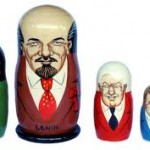 Years ago my sister traveled toEastern Europe,Russia, and theUkraineon a mission trip. She worked among the indigenous Christians on a number of worthy projects. And when her time ran up, she returned home with a heart full of joy, a head full of memories, and bags full of strange and wonderful souvenirs.
Years ago my sister traveled toEastern Europe,Russia, and theUkraineon a mission trip. She worked among the indigenous Christians on a number of worthy projects. And when her time ran up, she returned home with a heart full of joy, a head full of memories, and bags full of strange and wonderful souvenirs.
Since I’m the only twin brother my sister has, she brought me a unique gift. I got a set of Babushka dolls, those traditional Russian nesting dolls. When you open the first doll it has a smaller doll on the inside, so on and so forth, until you reach a tiny weeble-wobble deep within.
Actually my gift wasn’t that special. You can pick up Babushkas for pennies on the rubles. When my sister thought of me she probably thought, “How little can I spend and still appear thoughtful.” Whatever. I know how it works.
Anyway, this was after Russian Perestroika, Polish Solidarity, and the other movements that unhinged communism inEastern Europe. Boris Yeltsin was president of what was left of the Soviet regime.
The outer doll of my Babushka set was, entertainingly, Boris Yeltsin. His likeness had a dopey little smile and rumpled hair as if he had been drinking too much vodka, accurately portrayed I fear.
When Yeltsin was opened, there was Gorbachev with the familiar birth mark on his forehead. Inside Gorbachev was Khrushchev, then Josef Stalin, and finally Vladimir Lenin himself. I now keep all these little Communists boxed in the attic. They are much too dangerous to be let loose in the world again.
The deeper you went within the dolls, the closer you got to the essence of Soviet power, its source and beginning. As layer after layer fell away, and finally you held a tiny characterization of Lenin in your hand, you could truthfully say, “Ah, now I’ve gotten to the bottom of it all. This is the seed, the kernel from which all others grew.”
I, and many others, have tried this with Jesus. We all do, I suppose. We have struggled to unravel him, to break open his shell, and then the next, and the next, and the next. Then, we think we can get to the bottom of who he is.
We reconstruct his historical setting. We dissect his words. We set out to determine who he “really was” and is. But there is a problem. When dealing with this Jesus, we do not find ourselves moving to something smaller and more manageable.
The deeper we go, and as the layers fall away, we move to something greater. He gets larger, more uncontrollable, more inconceivable, more wonderful than our minds can imagine. We are the ones left to weeble and wobble.
Yet, there is a seed, a core to the historical Jesus as well as the exalted Christ of our faith. It is the element of sacrifice. There at the end of it all, when the onion is peeled, is a cross. Jesus, for two millennia, has been marked by this instrument of death.
More accurately, he has been marked by the cross since before the threads of time were ever spun. He was “slain before the foundations of the world,” John the revelator said.
There is a cross hanging above my desk where these words are being typed. I wear a crucifix around my neck. I even have a Celtic version of the symbol inked into my skin. And while I behold the cross every day, I cannot take hold of all its implications.
C. S. Lewis challenges us to look at the cross, not as a display of godly anger toward Jesus or the world, but as a Lover absorbing the shame and humiliation of betrayal and unfaithfulness. Lewis said, “Jesus shows on the cross that God’s love is not about violence and retaliation. The cross is the only true language of forgiveness.”
That stick of wood is a display of agonizing love shown to a world lost in self-centeredness and self-delusion, a world that has done nothing but be disloyal to and reject its Maker. The cross shows us how far Love will go: God, humiliated and bleeding in a suffering mess, bearing up underneath the betrayal of His own creation.
If you can get to the bottom of that, let me know. You’re a smarter person than most.

